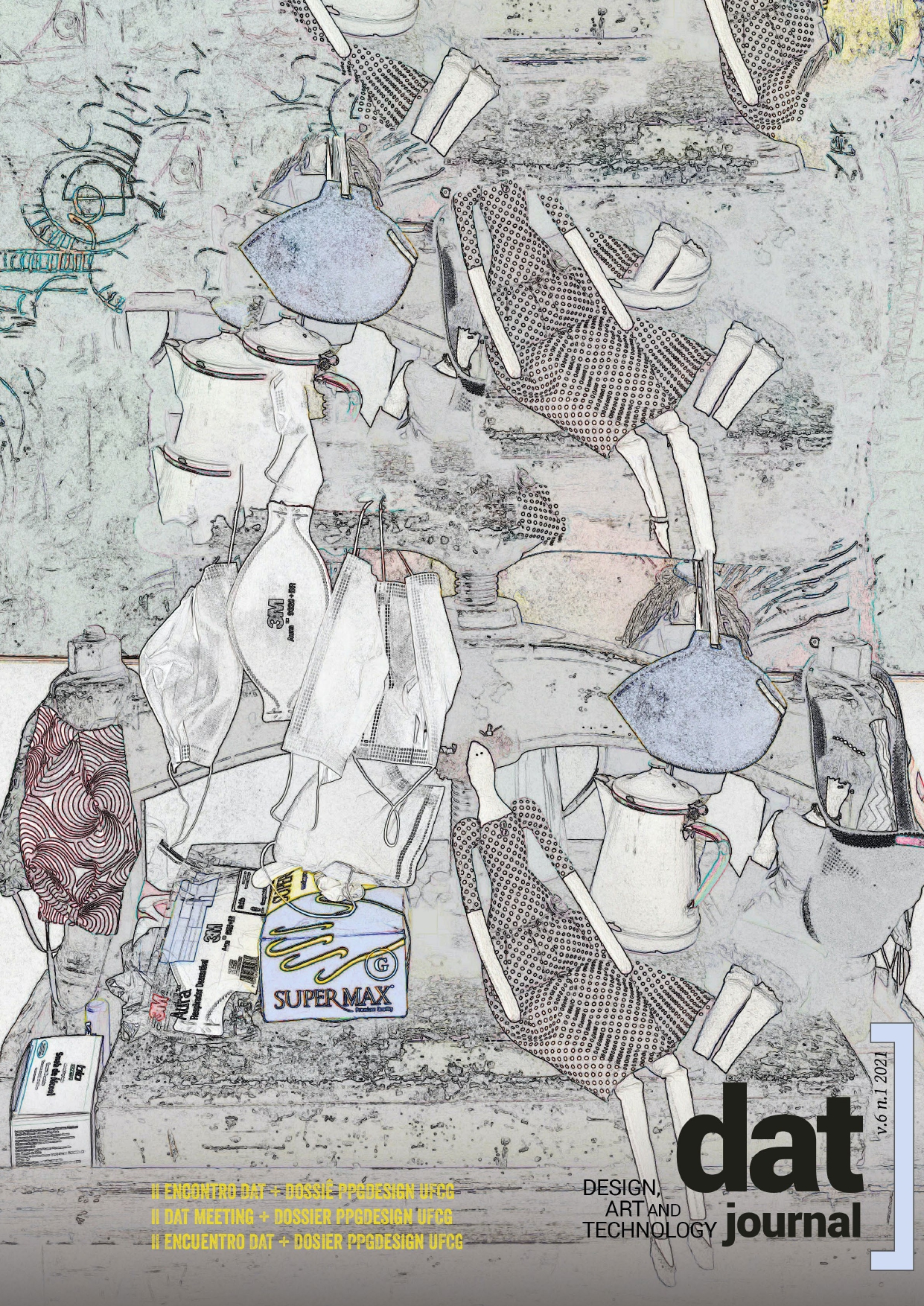La vuelta a los tintes naturales como forma de preservar el medio ambiente y su importancia histórica y cultural
DOI:
https://doi.org/10.29147/dat.v6i1.341Palabras clave:
Medio ambiente, Tintes naturales, Diseño, CulturaResumen
La moda está presente en nuestro día a día, a través de nuestra ropa nos comunicamos de forma no verbal. En este sentido, el color es una parte importante, sin embargo la industria del teñido de textiles causa varios problemas al medio ambiente. Por tanto, una posible alternativa es el uso de tintes naturales. Este trabajo tuvo como objetivo resaltar los tintes naturales como alternativa ecológica para la industria de la moda, además de su importancia cultural e histórica. Para ello, se realizó una búsqueda en la literatura que incluyó artículos y libros sobre tintes naturales, tanto en el área de Diseño, como en áreas afines. La literatura señaló que es posible utilizar técnicas de teñido antiguas, muchas de las cuales son respetuosas con el medio ambiente. La vuelta a las viejas prácticas puede contribuir tanto a la generación de empleo, como a la valorización del conocimiento y la cultura de diferentes pueblos.
Descargas
Citas
CASSELMAN, K. D. Praxis and Paradox: the culture of natural dyes in Britain, 1750-1900. Textile, v. 7, n. º 1, p. 6 - 27, 2009.
CHAN-BACAB, M. J et al. Characterization and dyeing potential of colorant-bearing plants of the Mayan área in Yucatan Peninsula, Mexico. Journal of Cleaner Production, v. 91, p.191-200, mar 2015.
CONVENTION FOR THE SAFEGUARDING OF INTANGIBLE CULTURAL HERITAGE, 32, 2003, Paris. Convention for the Safeguarding of Intangible Cultural Heritage. Paris: UNESCO, 2003.
CUNNINGHAM, A. B. et al. Hanging by a thread: natural metallic mordant processes in traditional indonesian textiles. Economic Botany, v. 65, n. º 3, p.241-259, mai 2011.
DITTY, S. It’s time for fashion revolution. White Paper, p.1-29, dez 2015.
FORSTER; S. V.; CHRISTIE, R. M. The significance of the introduction of synthetic dyes in the mid 19th century on the democratisation of western fashion. Journal of the International Colour Association, Leeds, v. 11, p. 1 -17, 2013.
GOMES, A. V. S.; COSTA, N. R. V.; MOHALLEM, N. D. S. Os tecidos e a nanotecnologia. Química Nova na Escola, v. 38, n. º 4, p.288-296, nov 2016.
GUIROLA, C. Natural dyes used in Mesoamerica since prehispanic age. Guatemala: Asociacion FLAAR Mesoamericana, 2010.
HANDAYANI, W.; KRISTIJANTO, A. I.; HUNGA, A. I. R. A water footprint case study in Jarum village, Klaten, Indonesia: the production of natural-colored batik. Environment, Development and Sustainability, p.1-14, fev 2018.
ISENMANN, A. F. Corantes. Timóteo: 2014.
JANSEN, S. et al. Aluminum hyperaccumulation in angiosperms: a review of Its phylogenetic significance. The Botanical Review, v. 68, n. º 2, p.235-269, abr 2002.
KADOLPH, S. Natural dyes: a traditional craft experiencing new attention. Delta Kappa Gamma Bulletin, p.14-17, fall 2008.
KANT, R. Textile dyeing industry an environmental hazard. Natural Science, Chandigarh, v.4, n. º 1, p.22-26, jan 2012.
MAGNUSDOTTIR, A. How fashion manufacturing will change after the Coronavirus. In: Forbes, 2020 (https://www.forbes.com/sites/aslaugmagnusdottir/2020/05/13/fashions-next-normal/#7c2152a278f3)
NURSE, K. Culture as The Fourth Pillar of Sustainable Development. Commonwealth Secretariat, v. 11, p. 28-40, abr 2007
PEZZOLO, D. B. Tecidos: histórias, tramas, tipos e usos. 4. ed. São Paulo: Editora Senac São Paulo, 2013.
ROCHA, A. A. Amaria, design e cooperação. São Paulo: Auana, 2018.
RODRIGUES, J.; ARAÚJO, M. de C. Corantes naturais amazônicos: um estudo para a aplicação em produtos têxteis de moda. Diálogos e Ciência, n. º 34, p. 65-71, 2013.
RODRIGUES, J. A. R. Uso de corantes de origem natural para o tingimento de artigos têxteis de moda. 2013. 130 f. Dissertação (Mestrado em Têxtil e Moda) - Escola de Artes, Ciências e Humanidades, Universidade de São Paulo, São Paulo, 2013.
SCHULTE, N. K. et al. A moda no contexto da sustentabilidade. Modapalavra E-periódico, v. 6, n. º 12, p.194-211, jul/dez 2013.
SHAHID, M.; ISLAM, S.; MOHAMMAD, F. Recent advancements in natural dye applications: a review. Journal of Cleaner Production, v. 53, p.310-331, ago 2013.
TERINTE, N. et al. Environmental assessment of coloured fabrics and opportunities for value creation: spin-dyeing versus conventional dyeing of modal fabrics. Journal of Cleaner Production, v.72, p.127 - 138, fev 2014.
TRANSFORMING OUR WORLD: THE 2030 AGENDA FOR SUSTAINABLE DEVELOPMENT, 2015,
New York. Resolution adopted by the General Assembly on 25 September 2015. New York: United Nations, 2015. In: United Nations, 2015.(https://www.un.org/ga/search/view_doc.asp?symbol=A/RES/70/1&Lang=E)
UNITED NATIONS CONFERENCE ON ENVIRONMENT & DEVELOPMENT,1992, Rio de Janeiro. Agenda 21. Rio de Janeiro: United Nations Sustainable Development, 1992. In: United Nations Sustainable Development, 1992. (https://sustainabledevelopment.un.org/content/documents/Agenda21.pdf)
UNITED NATIONS CONFERENCE ON SUSTAINABLE DEVELOPMENT RIO+20, 2012, Rio de Janeiro. Resolution adopted by the General Assembly on 27 July 2012. Rio de Janeiro: United Nations, 2012. In: United Nations, 2012. (https://www.un.org/ga/search/view_doc.asp?symbol=A/RES/66/288&Lang=E)
UNITED NATIONS CONFERENCE ON THE HUMAN ENVIRONMENT, 1972, Stockholm. Report of the United Nations Conference on the Human Environment. Switzerland: United Nations, 1973. In: United Nations, 1972. (https://unesdoc.unesco.org/ark:/48223/pf0000004437)
SARAVANAN, D.; NITHYAPRAKASH, V. Fashion trends and their impact on the society. In: Conference on textile, Apparels and Fashion, Coimbatore, 2015. In: ResearchGate, 2015. (https://www.researchgate.net/publication/282571020_Fashion_trends_and_their_impact_on_the_society)
VIANA, T. C. et al. O design de moda como ferramenta na utilização de pigmentos naturais na indústria têxtil. In: SIMPÓSIO DE DESIGN SUSTENTÁVEL, 5., 2015, Rio de Janeiro. Anais do 5° Simpósio Brasileiro de design Sustentável. São Paulo: Blucher, 2016, p. 401- 410.
ZANONI, M. V. B.; YAMANAKA, H. Corantes: caracterização química, toxicológica, métodos de detecção e tratamento. São Paulo: Cultura Acadêmica, 2016.


























